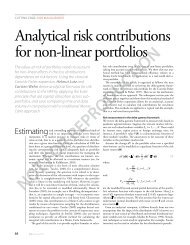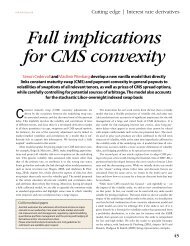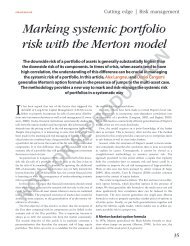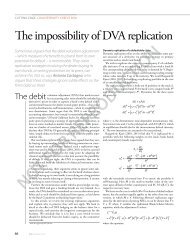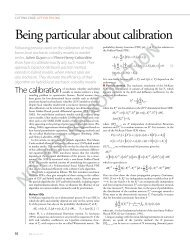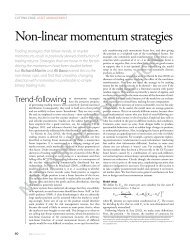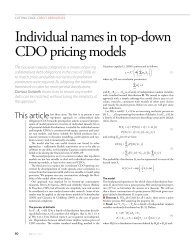The vanna-volga method for implied volatilities (PDF - Risk.net
The vanna-volga method for implied volatilities (PDF - Risk.net
The vanna-volga method for implied volatilities (PDF - Risk.net
You also want an ePaper? Increase the reach of your titles
YUMPU automatically turns print PDFs into web optimized ePapers that Google loves.
cutting edge.option pricing<br />
also be a convex function of the strike K, that is, (d 2 C)/(dK 2 )(K) ><br />
0 <strong>for</strong> each K > 0. This property, which is not true in general, 10<br />
holds <strong>for</strong> typical market parameters, so that (7) leads to prices<br />
that are arbitrage-free in practice.<br />
<strong>The</strong> VV <strong>implied</strong>-volatility curve K → ς(K) can be obtained by<br />
inverting (7), <strong>for</strong> each considered K, through the BS <strong>for</strong>mula. An<br />
example of such a curve is shown in figure 1. Since, by<br />
construction, ς(K i ) = s i , the function ς(K) yields an interpolationextrapolation<br />
tool <strong>for</strong> the market-<strong>implied</strong> <strong>volatilities</strong>.<br />
Comparison with other interpolation rules<br />
Contrary to other interpolation schemes proposed in the financial<br />
literature, the VV pricing <strong>for</strong>mula (7) has several advantages. It<br />
has a clear financial rationale supporting it, based on the hedging<br />
argument leading to its definition; it allows <strong>for</strong> an automatic<br />
calibration to the main volatility data, being an explicit function<br />
of s 1 , s 2 , s 3 ; and it can be extended to any European-style<br />
derivative (see the second consistency result, page 43). To our<br />
knowledge, no other functional <strong>for</strong>m enjoys the same features.<br />
Compared, <strong>for</strong> example, with the second-order polynomial<br />
function (in D) proposed by Malz (1997), the interpolation (7)<br />
equally perfectly fits the three points provided, but, in accordance<br />
with typical market quotes, boosts the volatility value both <strong>for</strong> low-<br />
and high-put deltas. A graphical comparison, based on market<br />
data, between the two functional <strong>for</strong>ms is presented in figure 1,<br />
where their difference at extreme strikes is clearly highlighted.<br />
<strong>The</strong> interpolation (7) also yields a very good approximation of<br />
the smile induced, after calibration to strikes K i , by the most<br />
renowned stochastic-volatility models in the financial literature,<br />
especially within the range [K 1 , K 3 ]. This is not surprising, since<br />
the three strikes provide in<strong>for</strong>mation on the second, third and<br />
fourth moments of the marginal distribution of the underlying<br />
asset, so that models agreeing on these three points are likely to<br />
produce very similar smiles. As a confirmation of this statement,<br />
in figure 1, we also consider the example of the stochastic alpha<br />
beta rho (SABR) functional <strong>for</strong>m of Hagan, et al. (2002), which<br />
has become a standard in the market as far as the modelling of<br />
<strong>implied</strong> <strong>volatilities</strong> is concerned. <strong>The</strong> SABR and VV curves tend<br />
42 risk South Africa Autumn 2007<br />
������������<br />
���������<br />
����������<br />
A. discount factors: July 1, 2005<br />
expiry dollar euro<br />
3M: october 3, 2005 0.9902752 0.9945049<br />
B. Strikes and <strong>volatilities</strong> corresponding to the three<br />
main deltas: July 1, 2005<br />
delta Strike Volatility<br />
25d put 1.1720 9.79%<br />
At-the-money 1.2115 9.375%<br />
25d call 1.2504 9.29%<br />
to agree quite well in the range set by the two 10D options (in the<br />
given example they almost overlap), typically departing from each<br />
other only <strong>for</strong> illiquid strikes. <strong>The</strong> advantage of using the VV<br />
interpolation is that no calibration procedure is involved, since<br />
s 1 , s 2 , s 3 are direct inputs of (7).<br />
Figure 1 compares the volatility smiles yielded by the VV price<br />
(7), the Malz (1997) quadratic interpolation and the SABR<br />
functional <strong>for</strong>m 11 , plotting the respective <strong>implied</strong> <strong>volatilities</strong> both<br />
against strikes and put deltas. <strong>The</strong> three plots are obtained after<br />
calibration to the three basic quotes s 1 , s 2 , s 3 , using the following<br />
euro/dollar data as of July 1, 2005 (provided by Bloomberg): T =<br />
3M, 12 S 0 = 1.205, s 1 = 9.79%, s 2 = 9.375%, s 3 = 9.29%, K 1 =<br />
1.1720, K 2 = 1.2115 and K 3 = 1.2504 (see also tables A and B).<br />
Once the three functional <strong>for</strong>ms are calibrated to the liquid quotes<br />
s 1 , s 2 , s 3 , one may then compare their values at extreme strikes with<br />
the corresponding quotes that may be provided by brokers or<br />
market-makers. To this end, in figure 1, we also report the <strong>implied</strong><br />
<strong>volatilities</strong> of the 10D put and call options (respectively, equal to<br />
10.46% and 9.49%, again provided by Bloomberg) to show that the<br />
Malz (1997) quadratic function is typically not consistent with the<br />
quotes <strong>for</strong> strikes outside the basic interval [K 1 , K 3 ].<br />
10 One can actually find cases where the inequality is violated <strong>for</strong> some strike K.<br />
11 We fix the SABR b parameter to 0.6. Other values of b produce, anyway, quite similar calibrated<br />
<strong>volatilities</strong>.<br />
12 To be precise, on that date the three-month expiry counted 94 days.<br />
���������������<br />
���������<br />
�������<br />
��������<br />
Untitled-1 1 5/1/07 12:42:24




